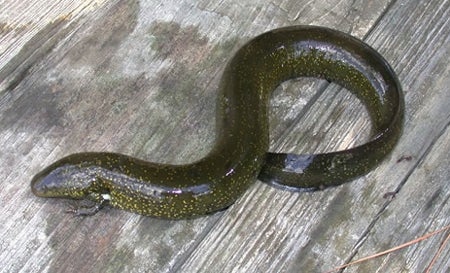SCIENTIFIC NAME:
Siren lacertina
STATUS:
Poorly known. Known from only one location in Alabama, a pond in Southern Hilly Gulf Coastal Plain of Henry County. MODERATE CONSERVATION CONCERN.
DESCRIPTION:
The greater siren averages 20 to 30 inches in length with a few specimens reaching greater than 36”. They resemble the freshwater eel in appearance, but have external gills and very small forelegs. The forelegs have four toes each and may be hidden by the gills. Typically gray or olive in color, they can have greenish or yellowish dots and dashes along the sides. A few specimens exhibit dark spots on the head and back. Juveniles have a small dorsal fin and a light stripe on either side, which usually fade as they mature.
DISTRIBUTION:
From the Washington D.C. area south into central Florida and south Alabama.
HABITAT:
This large salamander will inhabit a variety of aquatic habitats from still, shallow wetlands to turbid creeks and streams.
FEEDING HABITS:
Greater sirens forage along the stream floor or in aquatic vegetation for mollusks, crustaceans, worms, and small fish. They also ingest vegetation while foraging for live prey.
LIFE HISTORY AND ECOLOGY:
Very little is known about the life history of the greater siren. Researchers in Florida have concluded they breed primarily in February and March, laying single or small clusters of eggs, later being fertilized externally by the male.
REFERENCES:
Conant, Roger. 1975. A Field Guide to Reptiles and Amphibians of Eastern and Central North America. Houghton Mifflin Co., Boston, MA. 442-443 pp.
Mount, Robert H. 1996. The Reptiles & Amphibians of Alabama. The University of Alabama Press. Tuscaloosa, AL. 144-145 pp.
AUTHOR: Matt Brock, Wildlife Biologist, Division of Wildlife and Freshwater Fisheries






